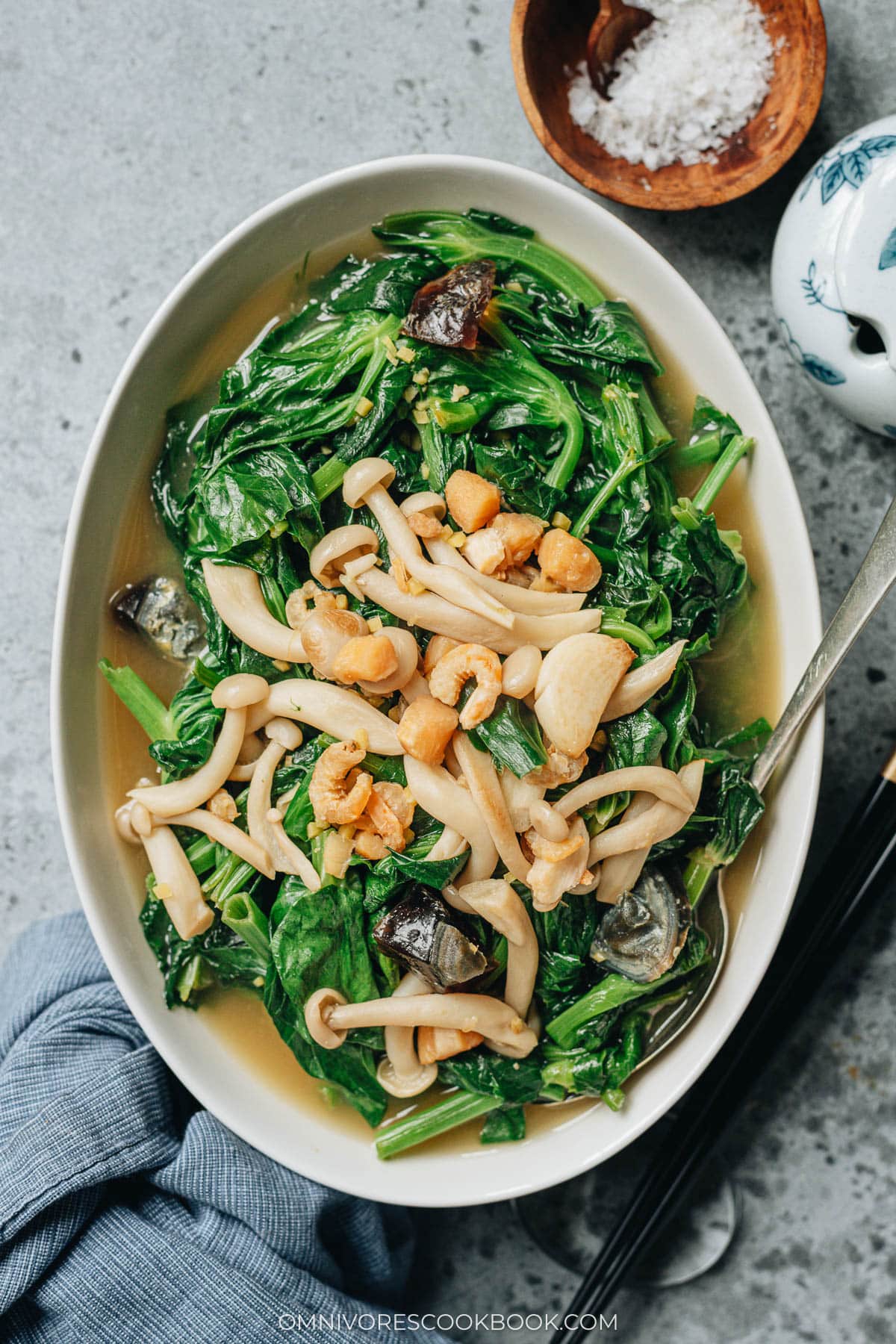
Chinese braised pea shoots, or 上汤碗豆尖 (Shàng Tāng Wǎn Dòu Jiān), can be directly translated to snow pea shoots braised in superior broth. It is a comforting vegetable side dish that showcases the natural sweetness and tenderness of fresh pea shoots. Light yet flavorful, the greens are braised in a savory broth enriched with garlic, and a touch of umami from century eggs, dried shrimp and scallops. It’s a classic Cantonese restaurant favorite that is easy enough to make for a weeknight dinner, and fantastic enough to serve for a celebratory occasion.
In this recipe, I want to introduce the version I enjoy the most. It uses shimeji mushrooms to add texture and color. I like to use both dried shrimp and dried scallops for umami, and century eggs for texture. I skipped the ham (also used in many traditional recipes) for a clean and delicate flavor.
Pea shoots in Chinese cooking
Pea shoots (豌豆苗 / 豆苗, dòu miáo) are the young, tender tips of the snow pea plant. They have delicate leaves, thin stems, and a mild, slightly grassy sweetness reminiscent of sugar snap peas. In Chinese cuisine, pea shoots are a seasonal delicacy, especially popular in late fall, winter and early spring when they’re most tender.
You’ll often find stir-fried pea shoots with garlic in Cantonese and Sichuan restaurants. But some restaurants serve the version made with “superior broth” (上汤) , a slightly upgraded version that makes the dish more delicate and luxurious.
Ingredients
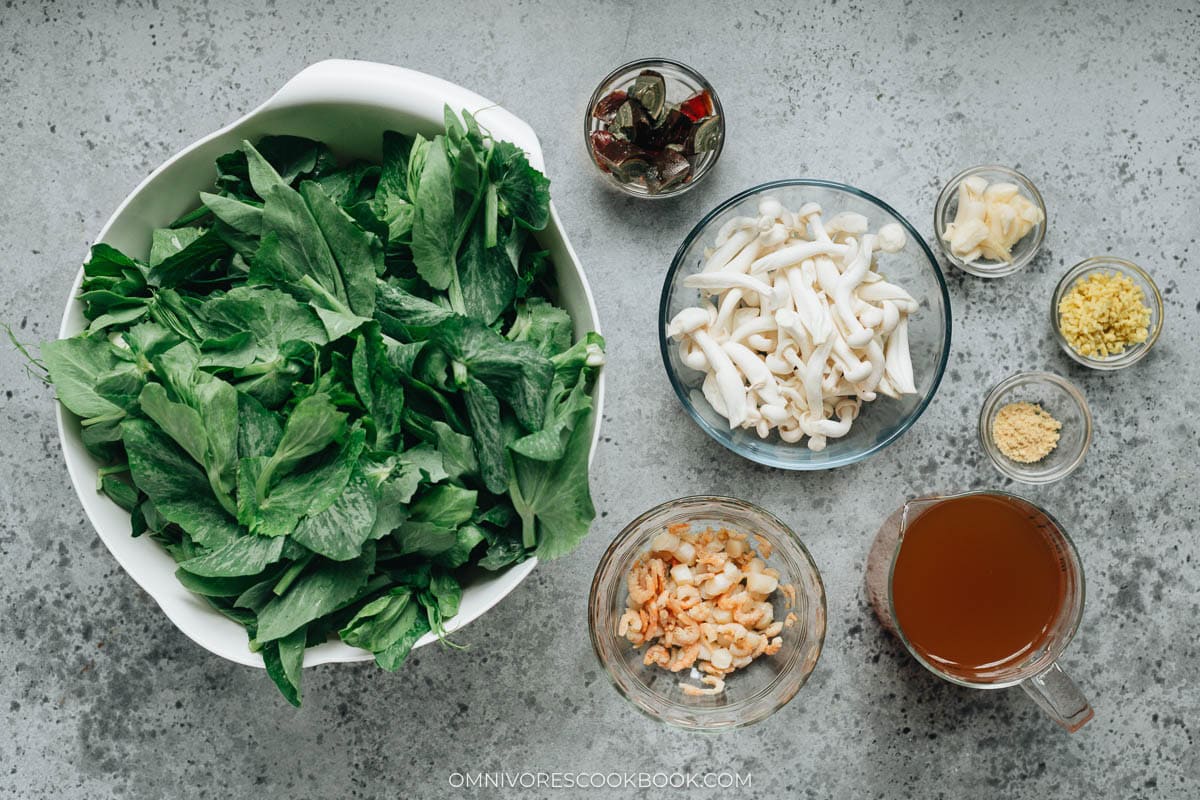
How to shop for pea shoots
You can often find snow pea shoots in large Asian markets and Chinese markets, sold by the bag. Note, these shoots are quite large and have thicker stems, making them different from the small and thin pea sprouts sometimes sold at farmer’s markets and Japanese markets.
Pea shoots are a cold weather crop and their peak season goes from fall, through winter and early spring. You should always buy pea shoots during peak season, otherwise they tend to be very fibrous and tough. Since they are often sold in open bags, you should check a pea shoot by snapping off the end of the stem. If it’s easy to snap off, the pea shoots are tender. If the stem is hard to break, the pea shoots might be too mature and will have a tough texture.
Dried scallops
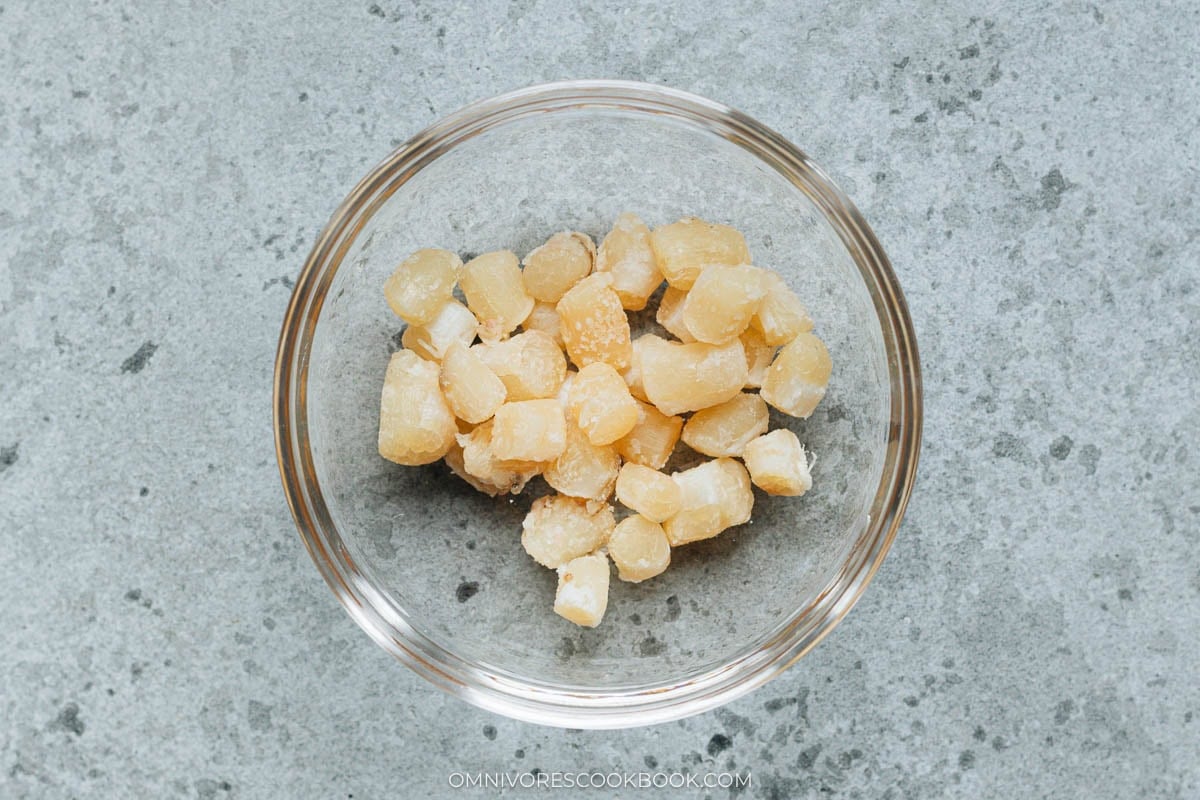
Dried scallops, (干贝, gān bèi), or Conpoy, is a type of dried seafood product that is commonly used in Chinese cooking such as seafood congee and xo sauce. It is made from the adductor muscles of scallops and tastes seafoody and tender once rehydrated. I always like to use dried scallops to infuse the broth with a rich umami. And the scallop itself is tasty, too
You can usually find this ingredient in the refrigerated section of Chinese and Asian markets.
Dried shrimp
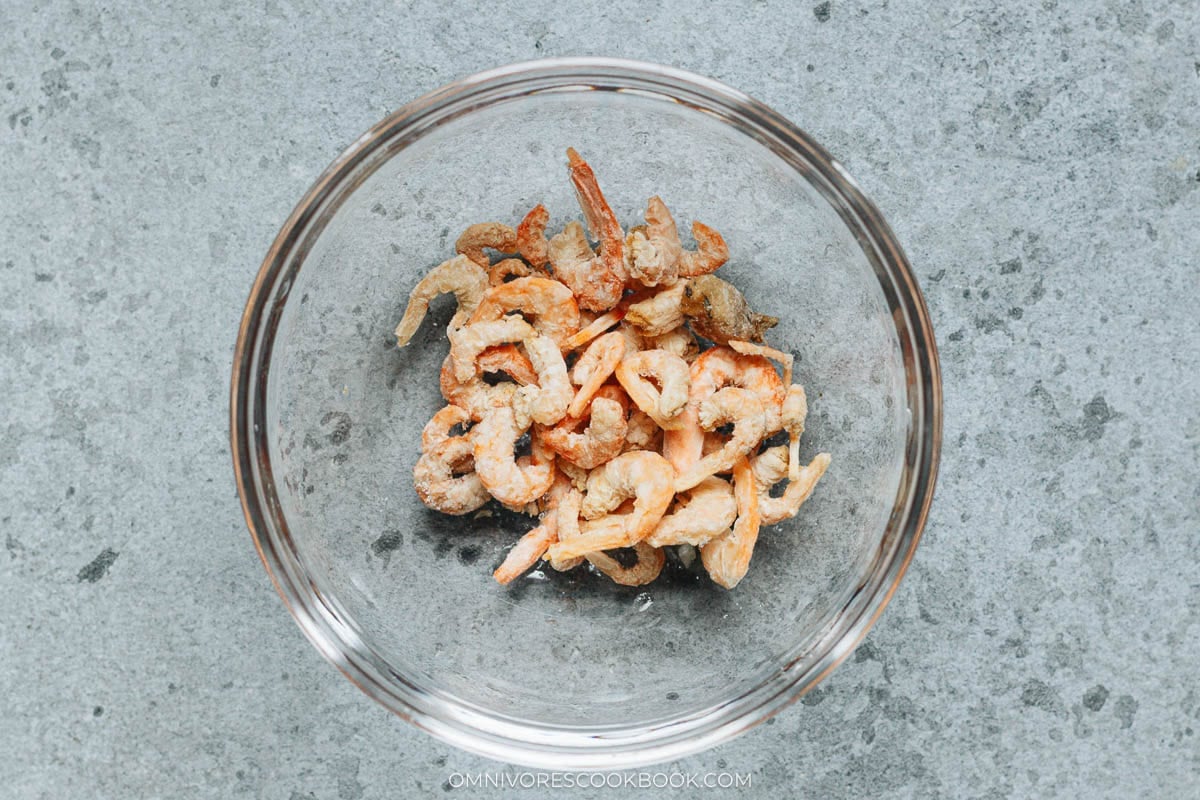
Dried shrimp, (海米, hǎi mǐ), means headless small dried shrimp that comes in different sizes. There are the shell-on and shell-less types, and I always use the shell-less type in my recipes for a better texture. Similar to dried scallops, it has a seafoody taste and a hint of sweetness. I like to use dried shrimp along with dried scallops to further add umami to the pea shoot broth.
You can usually find this ingredient in the refrigerated section of Chinese and Asian markets.
Century eggs
Century eggs (皮蛋, pí dàn) have a creamy yolk and a savory earthy flavor that infuses into the broth as it simmers. This deepens the taste of the “superior stock,” making it richer and more complex without needing extra seasoning. Century egg itself also adds texture to the dish.
You can usually find this ingredient in the refrigerated section of Chinese and Asian markets.
Chicken stock
When Chinese restaurants make braised pea shoots, the base broth is a rich stock made from a combination of chicken, pork, and dried ham. In a perfect world, you should make the broth using homemade chicken stock. But since I wanted to make this recipe more approachable, storeought chicken stock plus extra chicken bouillon powder will do the trick. I also used extra dried ingredients in my recipe to add umami and compensate for the boxed stock.
Other common ingredients in braised pea shoots
There are many different ways to put together braised pea shoots and every chef has their own approach and preferences when it comes to making the superior broth. Some of the most frequently used ingredients includes:
- Ham (either regular ham or dried ham), diced small – It’s a popular ingredient that many chefs like.
- Salted duck egg, diced – This can be used along with century egg to add another layer of umami and saltiness to the broth.
- Goji berries – It adds color and a light tanginess.
- Different types of mushrooms – Enoki and oyster mushrooms are both popular in this dish.
What pan to use?
I used a wok to cook this dish, because the shape is very easy for braising. But a deep medium pot or dutch oven works well too.
How to make
It might seem like braised pea shoots need a lot of specialty ingredients, but the dish is super easy to make.
Soak the dried scallops and shrimp. It’s best to use cold water for this process, so the ingredients preserve the most flavor. If you’re short on time, warm water (NOT boiling water) works too. The process rehydrates them and gets rid of some salt, so your dish won’t end up overly salty.
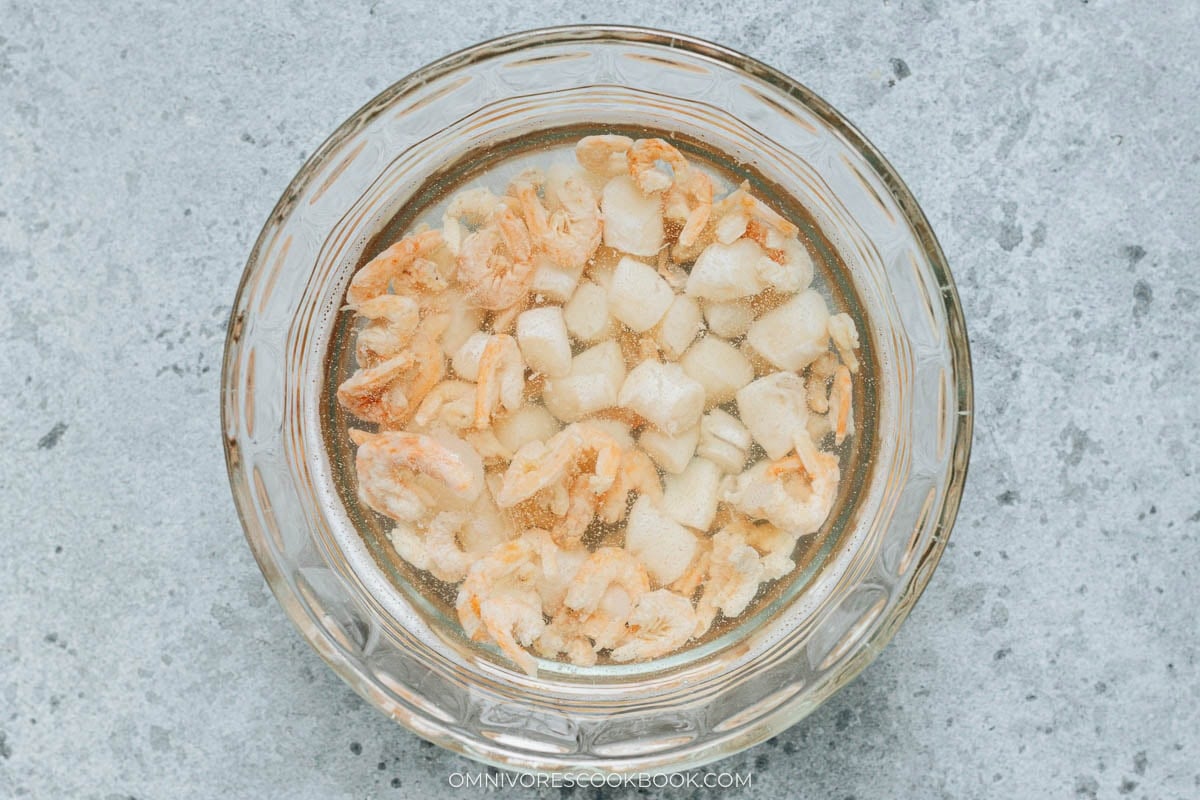
To start cooking, saute the garlic until golden.
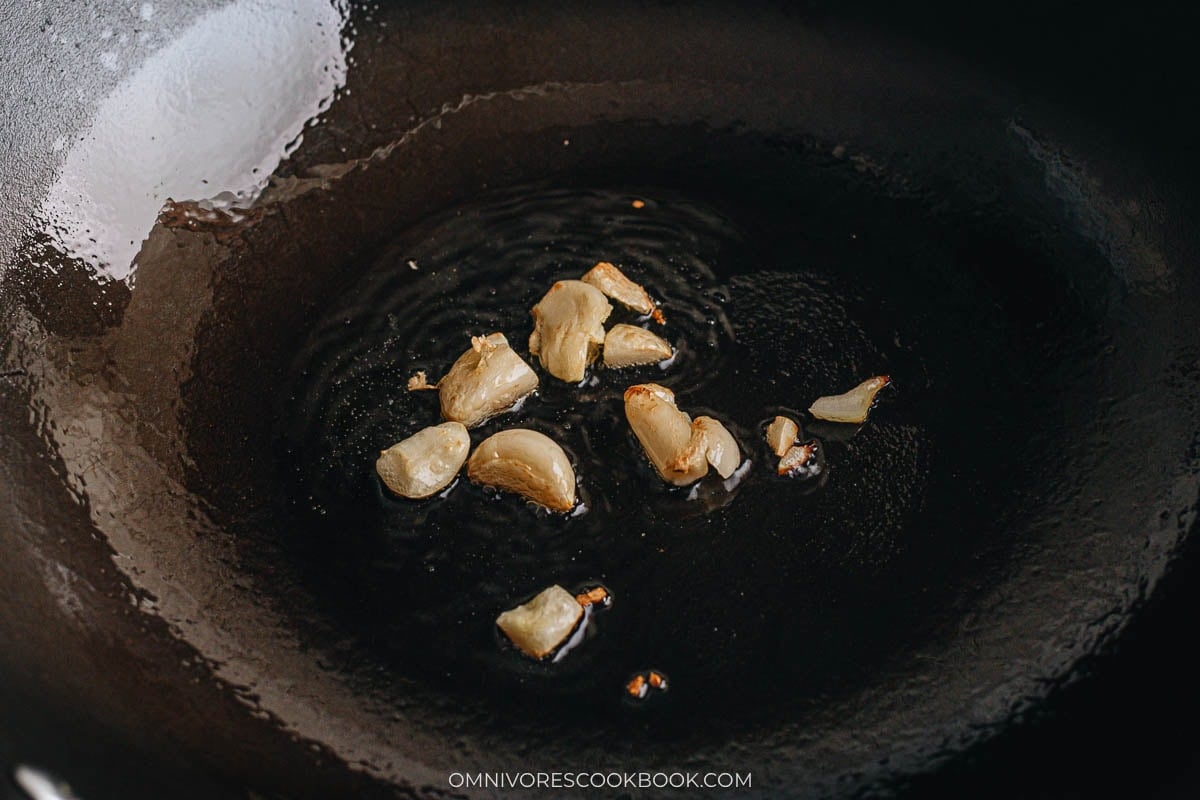
Then add the ginger, rehydrated dried scallop and rehydrated dried shrimp to infuse the oil.
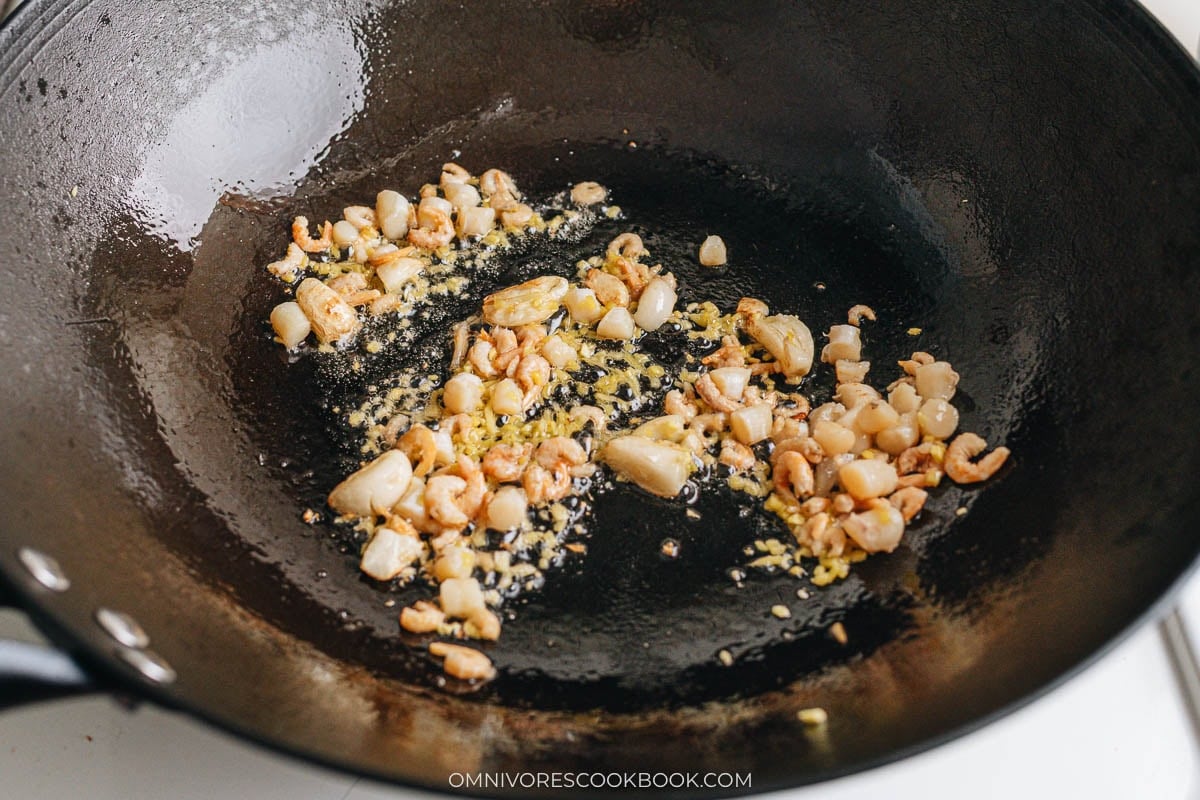
Next, cook the mushrooms until they just turn golden.
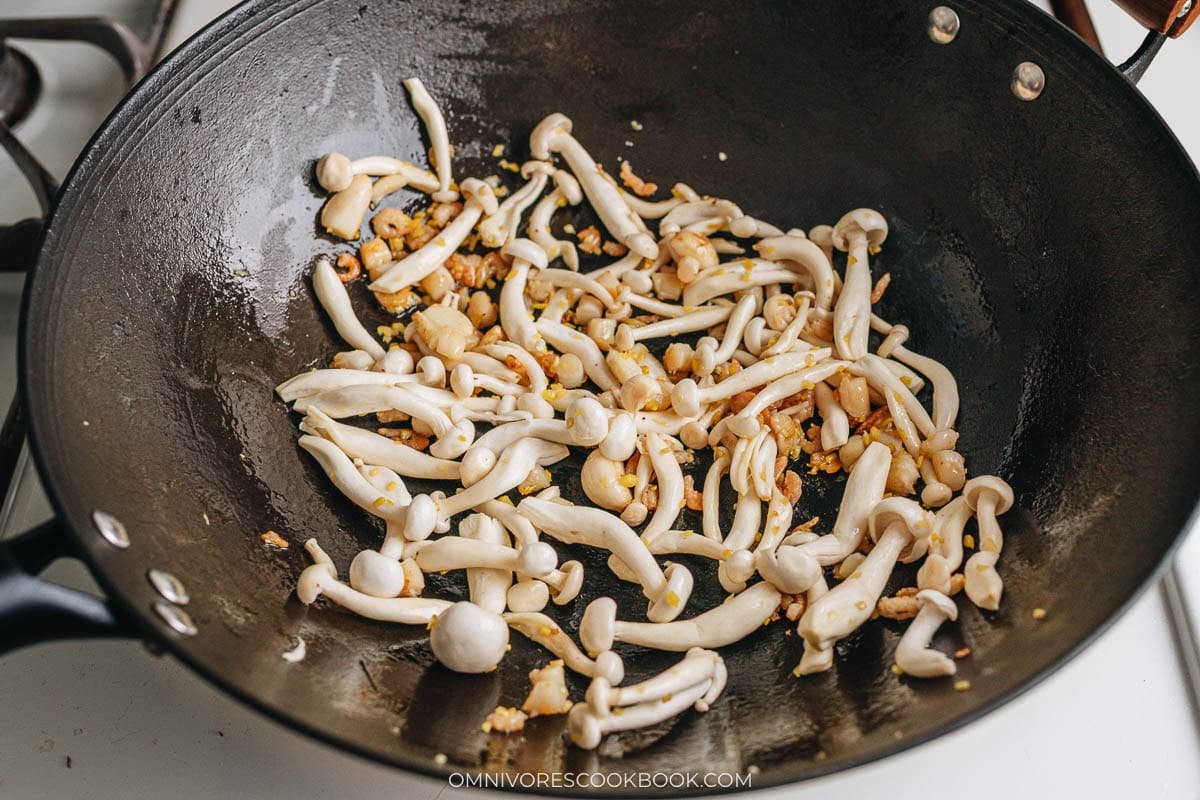
Add the broth and let it simmer. It’s important to let the broth boil for at least two minutes, to infuse the flavor of the dried ingredients and aromatics. It also helps to reduce the liquid a bit to get a more intense tasting broth.
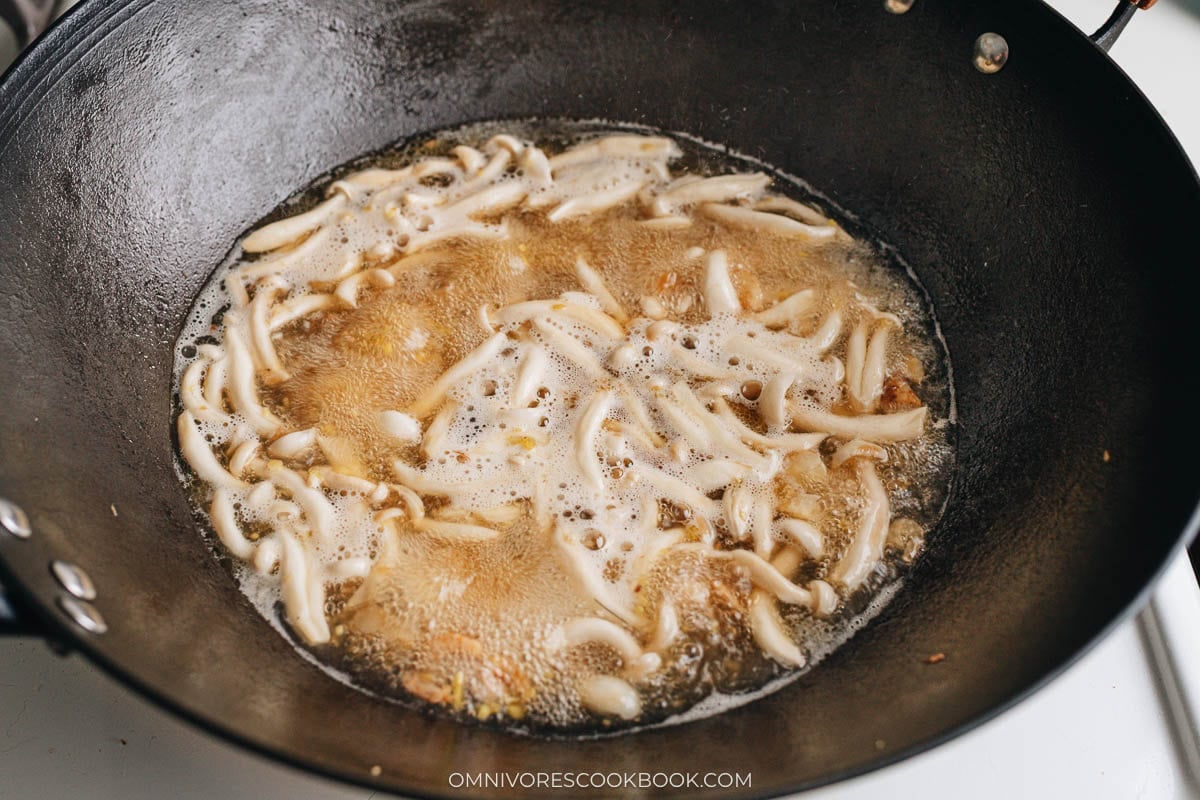
Add the pea shoots and cover to braise. It might look like a LOT of pea shots and most of them will not be in the broth at first. But that’s totally fine. They shrink a lot during braising.
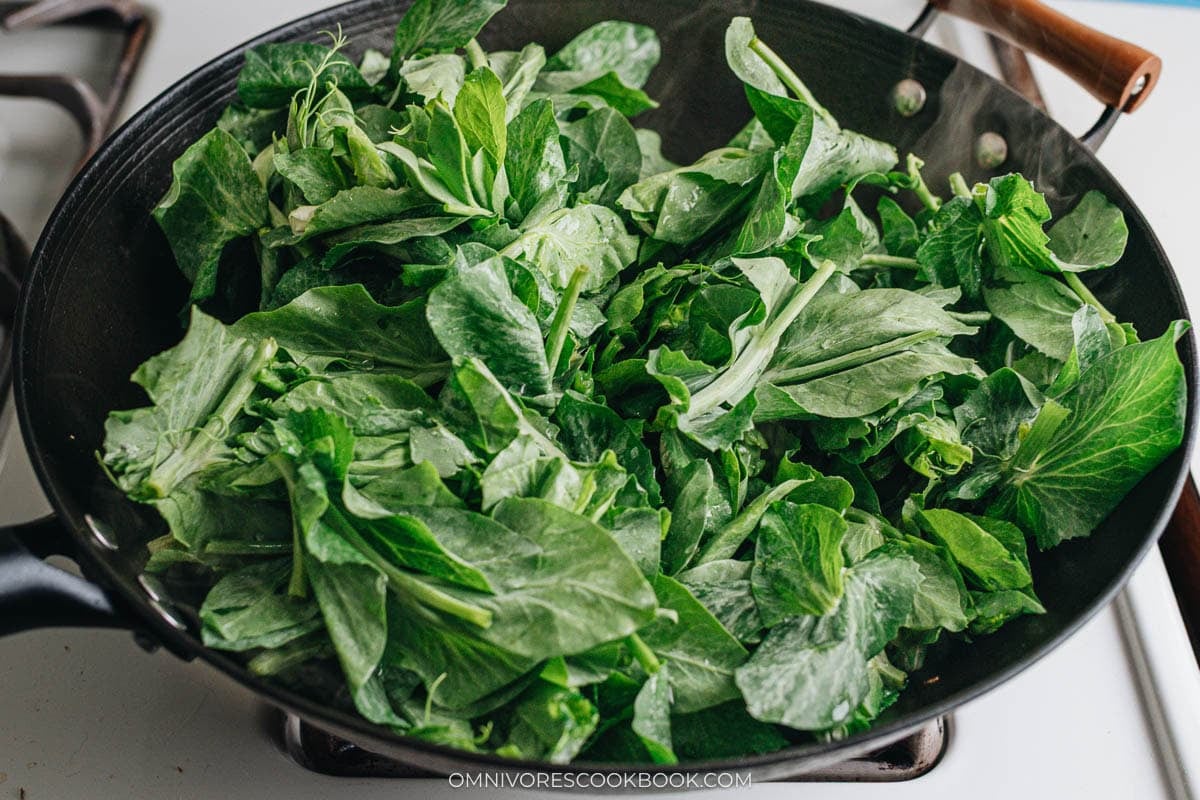
After two minutes, you will see most of the pea shoots covered in the broth. Stir to mix well and cover to braise for another 1 to 2 minutes. Pea shoots can stand some cooking. So taste a pea shoot and see if it’s tender enough to your liking.
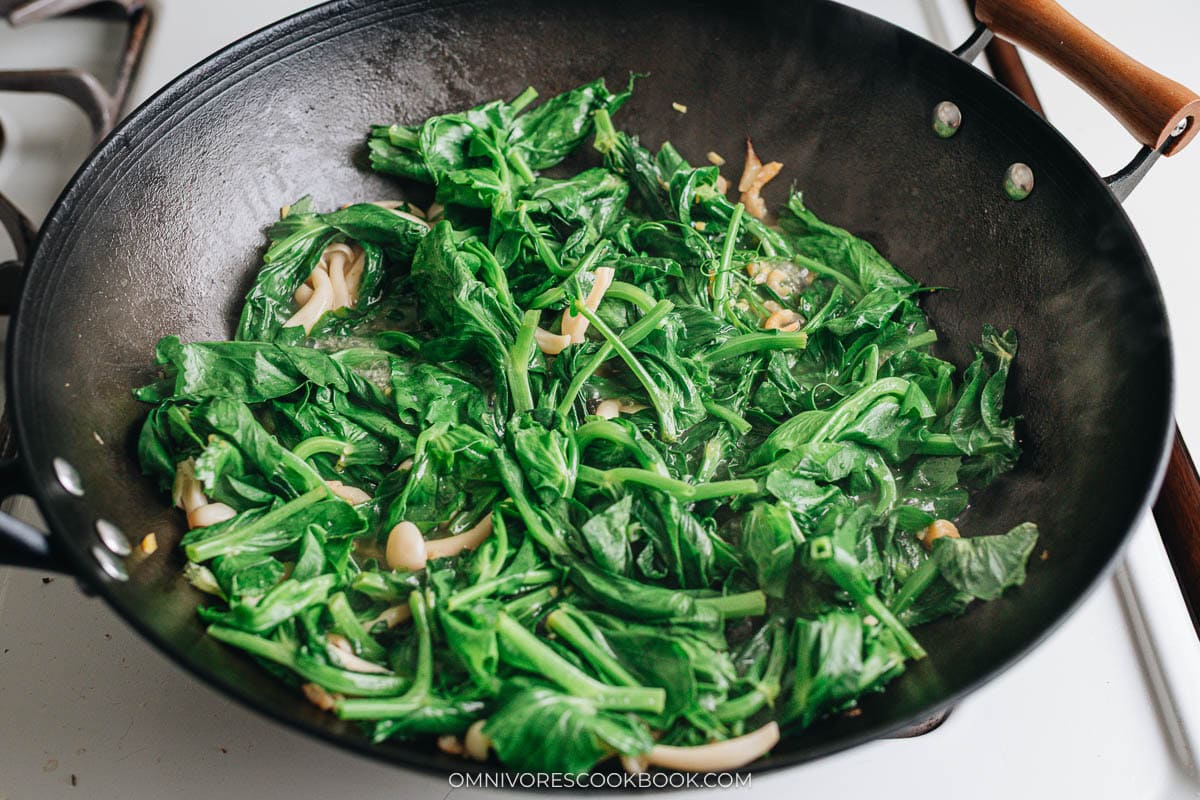
Once cooked, immediately transfer everything to a deep plate or a large bowl, so the pea shoots don’t overcook in the residual heat. I like to transfer the pea shoots first, then pour in the broth along with the rest of the ingredients. The dried ingredients and mushrooms will be mostly on the top, just like the way restaurants serve it.
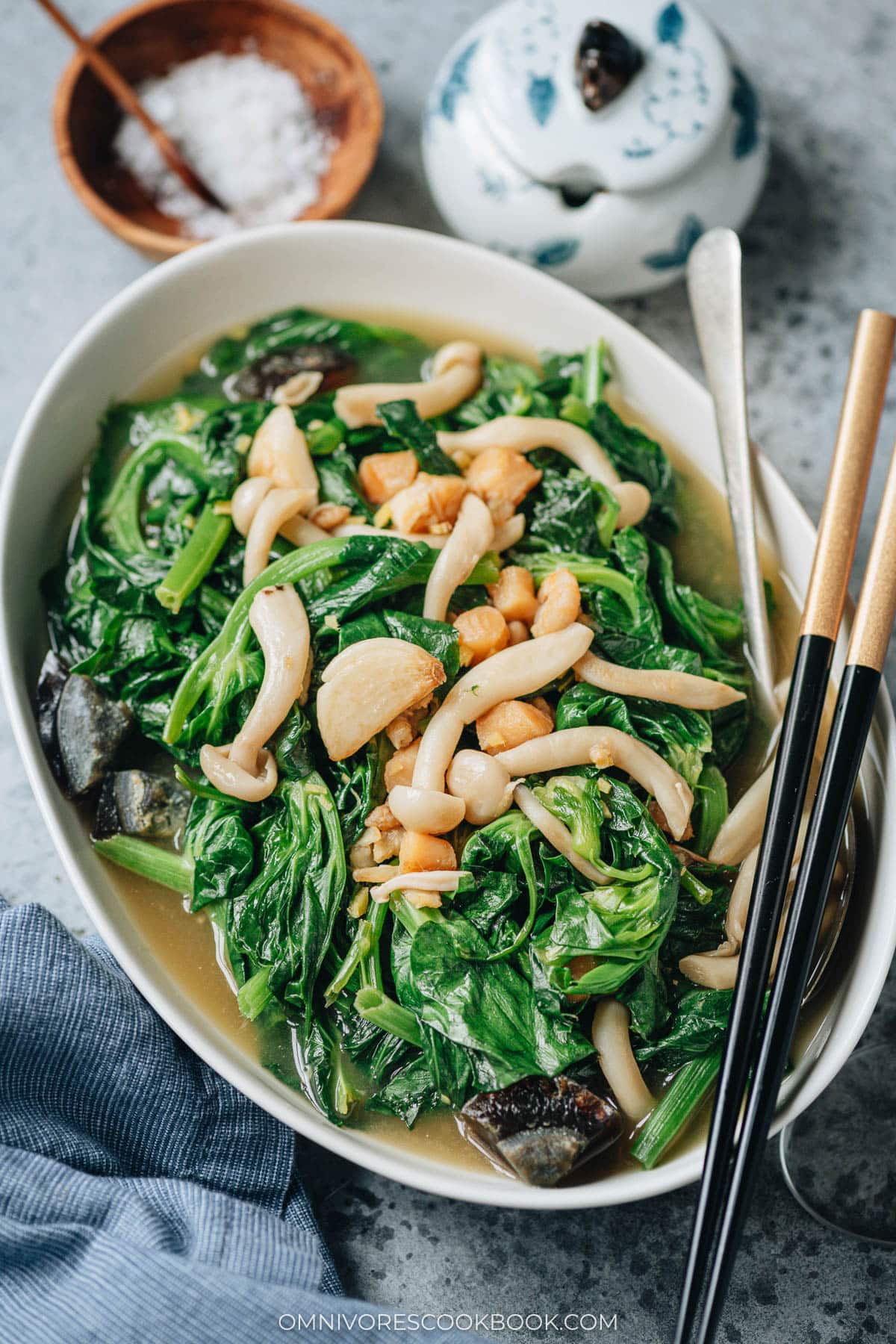
Different variations
The “braised in superior broth” method can be applied to many vegetables. In China, one of the other favorite variations is braised spinach (上汤菠菜). The other options are broccoli and baby napa cabbage.
How to serve
Serve braised pea shoots as a side dish along with other main dishes, appetizers, and a soup. The dish itself has a delicate flavor, yet is very satisfying due to the rich broth.
In a Cantonese meal setting, it’s often served with dishes such as fried noodles and fried rice and richer main dishes such as beef and Chinese broccoli. It’s a lighter dish that balances out the heavier dishes.
In a Sichuan meal setting, braised pea shoots are served with spicy dishes such as Dan Dan noodles, Sichuan mala chicken (La Zi Ji), and Mouth Watering Chicken (Kou Shui Ji) as a palette cleanser.
When you enjoy Chinese braised pea shoots, make sure to have a spoon along with your chopsticks, so you can drink some of the broth as you eat the pea shoots.
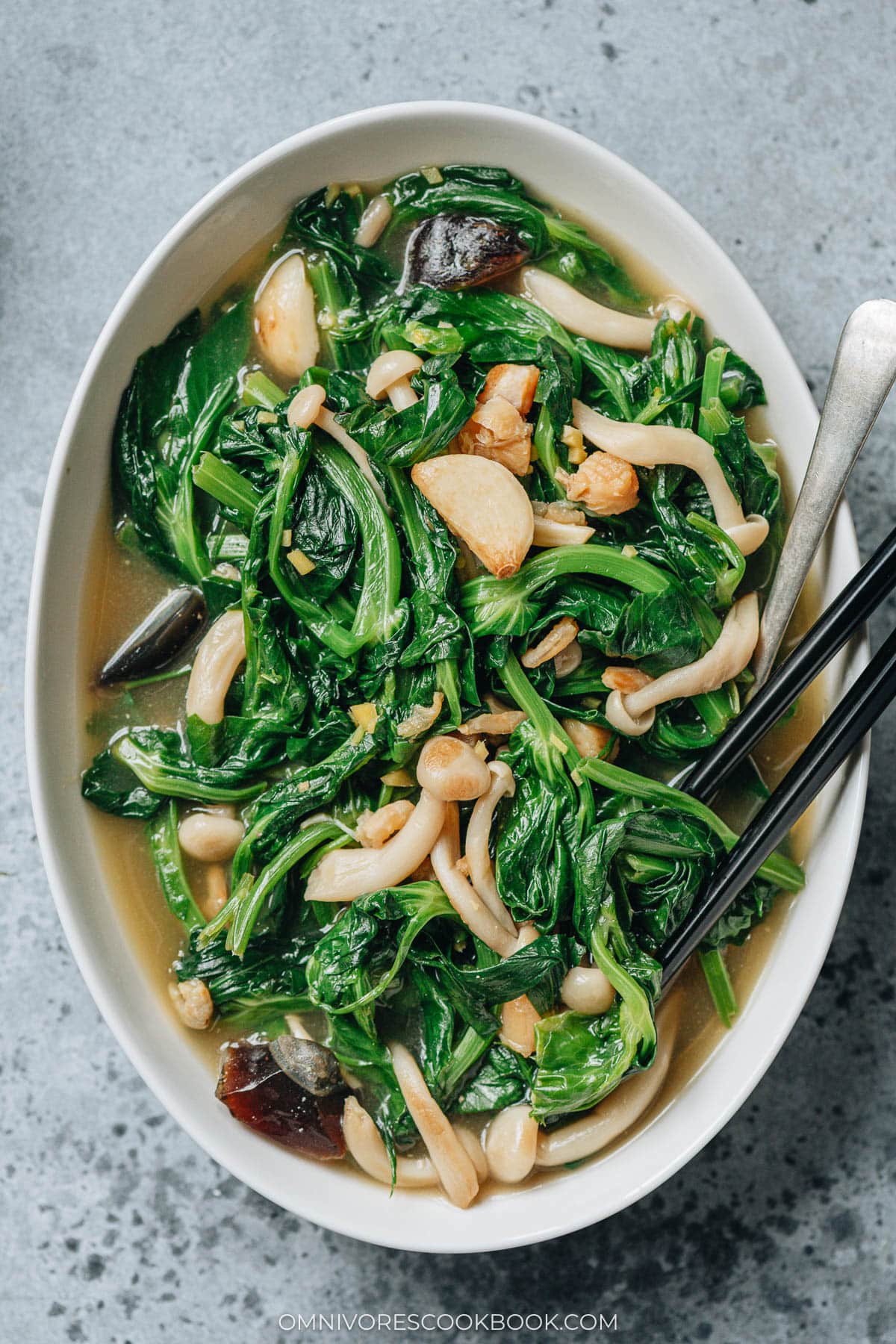
Frequently asked questions
How do I keep the pea shoots tender and bright green?
Cook the pea shoots very briefly without overcooking, and judge the texture by tasting during cooking. Depending on the pea shoots and how tender they originally were, the cooking time can vary. Overcooking will make their color duller.
Do I need to blanch the pea shoots before braising?
It’s a traditional practice but I find it unnecessary. Because pea shoots shrink a lot once heated, a quick blanch makes the pea shoots wilted, so they can submerge in the broth during the braising. But I found the process a little redundant, and if not done carefully, you can easily overcook them. I like to braise them directly by covering the pan, and let the steam cook the un-submerged parts very quickly.
How do I make the broth thicker like at a restaurant?
Restaurants make the broth from chicken, pork and ham from scratch, and it contains a lot of gelatin and a good amount of emulsified fat to make the broth nice and thick. The best way to achieve this texture is by using homemade chicken stock. For a shortcut approach, use 1 teaspoon cornstarch + 1 tablespoon of water to make a slurry, and add it at the end of the cooking to slightly thicken the broth.
Chinese Cooking Made Easy
Are you new to this website? This free email series is a great place to start. I’ll walk you through a few of my most popular recipes and show you how and why they work. You’ll quickly start to cook better Chinese food in your own kitchen.
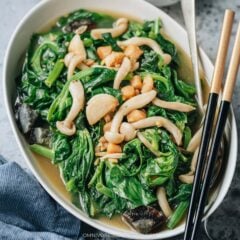
Chinese Braised Pea Shoots (上汤碗豆尖)
Ingredients
- 2 tablespoons dried scallops
- 2 tablespoons dried shrimp
- 1 lb snow pea shoots (*Footnote 1)
- 1 tablespoon peanut oil (or vegetable oil)
- 4 cloves garlic , gently smashed
- 2 teaspoons ginger , minced
- 1 pack (3.5 oz) white shimeji mushrooms
- 2 cups chicken stock
- 1/2 teaspoon chicken bouillon powder
- 1 century egg , peeled and diced
Instructions
- Add the dried scallop and dried shrimp into cold water and soak for 30 minutes. Then drain the soaking water. If short on time, you can also soak them in warm water for 10 minutes.
- Add the pea shoots into a big colander and cover with cold tap water. Soak for 5 minutes, rub gently with your hands, then drain. Check the ends of the pea shoot by feeling the cut side of the stem with your fingers with a snapping motion. If the ends are tough to snap, move up the stem until you can easily snap them off. Discard the fibrous tough stem ends. (*Footnote 2)
- Heat oil in a wok or a 4qt dutch oven over medium heat until shimmering. Add the garlic. Cook until the surface turns light golden.
- Add the ginger, rehydrated scallops, and rehydrated shrimp. Cook and stir for 30 seconds to release fragrance. Add the mushrooms. Cook over high heat until lightly browned.
- Pour in the chicken stock along the edge of the hot wok, to let it evaporate as much as you can. Cook over high heat until bringing to a boil. Let boil for 2 minutes, to infuse flavor and slightly reduce the broth.
- Add the century egg and the pea shoots. Cook covered for 2 minutes, until the pea shoots are wilted. Uncover, then stir to submerge the pea shoots in the broth. Cover to braise until the pea shoots are tender, or cooked to your preferred texture, 1 to 2 more minutes. Immediately transfer everything to a deep plate, so the pea shoots won’t overcook in the residual heat. Serve as a side dish.
Notes
- When shopping for snow pea shoots, try to snap the end of a pea shoot stem. If it is crisp and easy to snap, the pea shoots are tender and will taste much better when cooked. If it’s hard to snap, it means the pea shoots have grown for too long and will be quite tough and chewy. If you buy pea shoots during peak season and if most of them are tender, chances are, you can skip this “snapping” step to save time and your dish will still have a pretty good texture.
- Soaking the pea shoots gets rid of the surface dust. If you’re short on time, it’s not necessary to snap off the tough ends. But the pea shoots will have a much nicer texture if you do this step.
Nutrition

Did you make this recipe?
I’d love to hear how it turned out for you! Please take a moment to leave a 5-star rating ⭐️ and share your thoughts in the comments further down the page. It really helps others discover the recipe too.

Susan
“a 4” dutch oven” ??
Maggie Zhu
Sorry! It should be 4 qt. I just updated the recipe.